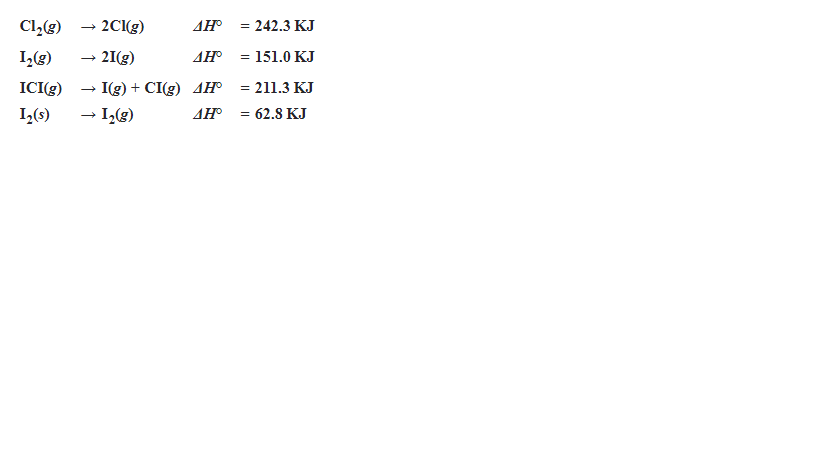
Chemistry
10th Edition
ISBN: 9781305957404
Author: Steven S. Zumdahl, Susan A. Zumdahl, Donald J. DeCoste
Publisher: Cengage Learning
expand_more
expand_more
format_list_bulleted
Concept explainers
Question
Using the following data, calculate the standard heat of formation of ICl(g) in kJ/mol:

Transcribed Image Text:Cl,()
2CI(g)
AH
= 242.3 KJ
I,(g)
21(g)
AH = 151.0 KJ
ICI9)
- I(g) + CI(g) AH = 211.3 KJ
I(s)
AH = 62.8 KJ
Expert Solution
This question has been solved!
Explore an expertly crafted, step-by-step solution for a thorough understanding of key concepts.
This is a popular solution
Trending nowThis is a popular solution!
Step by stepSolved in 3 steps with 1 images

Knowledge Booster
Learn more about
Need a deep-dive on the concept behind this application? Look no further. Learn more about this topic, chemistry and related others by exploring similar questions and additional content below.Similar questions
- When 1.42 g of iron reacts with 1.80 g of chlorine, 3.22 g of iron(II) chloride (FeCl2, molar mass = 126.75 g/mol) and 6.8 kJ of heat is produced. What is the enthalpy change for the reaction when 1 mole of iron(II) chloride is produced? round to sig figsarrow_forwardA particular sample of cold graphite at 10.20 °C was added to 988.5 g of water at 25.31 °C in a constant pressure calorimeter. If the final temperature of the graphite and water was 25.17 °C, what was the mass of the graphite sample? Assume no heat was lost to the surroundings. The specific heat for water is 4.184 J/g•°C and the specific heat for this graphite is 0.7069 J/g•°C.arrow_forwardThe lattice energy is defined as the energy required to break one mole of an ionic solid into its ions in the gas phase. The lattice energy for calcium oxide corresponds to the following reaction. CaO(s) Ca2+(g) + O2-(g) DH = ? Using the following information, determine the lattice energy for calcium oxide. Ca(s) ----> Ca(g) DH = 178.2 kJ Ca(g) ----> Ca2+(g) + 2e- DH = 1747.9 kJ O2(g) ----> 2O(g) DH = 498.3 kJ O2-(g) ----> O(g) + 2e- DH = -702 kJ Ca(s) + 1⁄2 O2(g) ----> CaO(s) DH = -635.0 kJ Using the unrounded answer from the previous problem determine q (kJ) for the following reaction when 1.00 grams of solid calcium oxide forms. Ca2+(g) + O2-(g) ⟶⟶ CaO(s)arrow_forward
- When 6.54 grams of Zn is placed in 500.0 mL of 1.00 M CuSO4(aq) in a coffee cup calorimeter, it reacts completely to displace copper. The temperature of the solution rises from 20.0˚C to 30.4˚C. Assume the coffee cup itself gains no heat and that the solution has the same density (1.00 g/mL) and specific heat (4.184 J/g˚C) as pure water. (a) How much heat does the solution gain during this reaction? (in J)arrow_forwardCalculate the enthalpy change for the reaction of magnesium and water using Hess’s Law.arrow_forwardWhen a 45.0 g sample of an alloy at 100.0 °C is dropped into 55.0 g of water at 25.0 °C, the final temperature is 30.4 °C. What is the specific heat of the alloy? The specific heat of H2O(l) is 4.184 J·g–1·°C–1. (A) 0.397 J·g–1·°C–1. (B) 0.447 J·g–1·°C–1. (C) 1.28 J·g–1·°C–1. (D) 1.55 J·g–1·°C–1.arrow_forward
- Calculate the change in enthalpy of the following reaction. ΔH (Fe3O4) = -1120.9 kJ ΔH (Al2O3) = -1669.8 kJ 8Al(s) + 3Fe3O4(s) -> 4Al2O3(s) + 9 Fe(sarrow_forwardThe enthalpy of formation of H2O(l) is -285.8 kJ/mol. What is the enthalpy change if 1.62 g H2(g) reacts with 9.21 g O2(g) to form H2O(l)?arrow_forward
arrow_back_ios
arrow_forward_ios
Recommended textbooks for you
 ChemistryChemistryISBN:9781305957404Author:Steven S. Zumdahl, Susan A. Zumdahl, Donald J. DeCostePublisher:Cengage Learning
ChemistryChemistryISBN:9781305957404Author:Steven S. Zumdahl, Susan A. Zumdahl, Donald J. DeCostePublisher:Cengage Learning ChemistryChemistryISBN:9781259911156Author:Raymond Chang Dr., Jason Overby ProfessorPublisher:McGraw-Hill Education
ChemistryChemistryISBN:9781259911156Author:Raymond Chang Dr., Jason Overby ProfessorPublisher:McGraw-Hill Education Principles of Instrumental AnalysisChemistryISBN:9781305577213Author:Douglas A. Skoog, F. James Holler, Stanley R. CrouchPublisher:Cengage Learning
Principles of Instrumental AnalysisChemistryISBN:9781305577213Author:Douglas A. Skoog, F. James Holler, Stanley R. CrouchPublisher:Cengage Learning Organic ChemistryChemistryISBN:9780078021558Author:Janice Gorzynski Smith Dr.Publisher:McGraw-Hill Education
Organic ChemistryChemistryISBN:9780078021558Author:Janice Gorzynski Smith Dr.Publisher:McGraw-Hill Education Chemistry: Principles and ReactionsChemistryISBN:9781305079373Author:William L. Masterton, Cecile N. HurleyPublisher:Cengage Learning
Chemistry: Principles and ReactionsChemistryISBN:9781305079373Author:William L. Masterton, Cecile N. HurleyPublisher:Cengage Learning Elementary Principles of Chemical Processes, Bind...ChemistryISBN:9781118431221Author:Richard M. Felder, Ronald W. Rousseau, Lisa G. BullardPublisher:WILEY
Elementary Principles of Chemical Processes, Bind...ChemistryISBN:9781118431221Author:Richard M. Felder, Ronald W. Rousseau, Lisa G. BullardPublisher:WILEY

Chemistry
Chemistry
ISBN:9781305957404
Author:Steven S. Zumdahl, Susan A. Zumdahl, Donald J. DeCoste
Publisher:Cengage Learning

Chemistry
Chemistry
ISBN:9781259911156
Author:Raymond Chang Dr., Jason Overby Professor
Publisher:McGraw-Hill Education

Principles of Instrumental Analysis
Chemistry
ISBN:9781305577213
Author:Douglas A. Skoog, F. James Holler, Stanley R. Crouch
Publisher:Cengage Learning

Organic Chemistry
Chemistry
ISBN:9780078021558
Author:Janice Gorzynski Smith Dr.
Publisher:McGraw-Hill Education

Chemistry: Principles and Reactions
Chemistry
ISBN:9781305079373
Author:William L. Masterton, Cecile N. Hurley
Publisher:Cengage Learning

Elementary Principles of Chemical Processes, Bind...
Chemistry
ISBN:9781118431221
Author:Richard M. Felder, Ronald W. Rousseau, Lisa G. Bullard
Publisher:WILEY